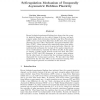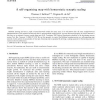71 search results - page 6 / 15 » Expressive Models for Synaptic Plasticity |
NIPS
2001
15 years 1 months ago
2001
Recent biological experimental findings have shown that the synaptic plasticity depends on the relative timing of the pre- and postsynaptic spikes which determines whether Long Te...
IJON
2007
14 years 11 months ago
2007
Intrinsic plasticity (IP) refers to a neuron’s ability to regulate its firing activity by adapting its intrinsic excitability. Previously, we showed that model neurons combinin...
IJON
2006
14 years 11 months ago
2006
Hebbian learning has been a staple of neural-network models for many years. It is well known that the most straight-forward implementations of this popular learning rule lead to u...
120
click to vote
NN
2002
Springer
14 years 11 months ago
2002
Springer
In this paper we implement a computational model of a neuromodulatory system in an autonomous robot. The output of the neuromodulatory system acts as a value signal, modulating wi...
ICANN
2005
Springer
15 years 5 months ago
2005
Springer
While synaptic learning mechanisms have always been a core topic of neural computation research, there has been relatively little work on intrinsic learning processes, which change...


